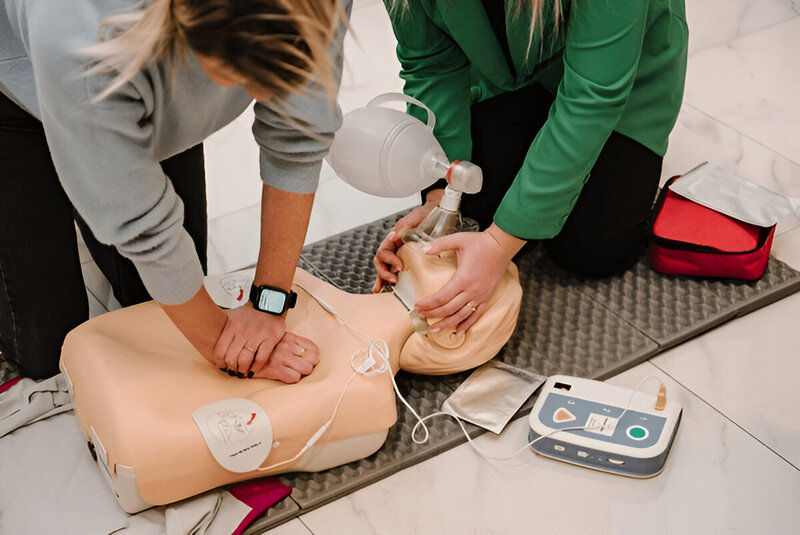How HLTAID009 Provide Cardiopulmonary Resuscitation Can Save Lives in Emergencies
- Lara Buck
- Aug 28, 2025
- 4 min read

An emergency may strike at any time without notice. These unexpected situations turn normal days into moments when quick, immediate action can go ahead to determine the outcome. One critical skill on the day could make a vast difference: CPR. The knowledge associated with HLTAID009 Provide Cardiopulmonary Resuscitation becomes paramount when one's role in the emergency is to save life.
Understanding HLTAID009 Provide Cardiopulmonary Resuscitation
HLTAID009 Provide Cardiopulmonary Resuscitation constitutes a nationally recognized unit of competence established to equip the learner with knowledge and practical skills for efficient intervention during cardiac emergencies. PowerPoint training is provided to deliver CPR theory and practice for helping adults, children, and infants in medical emergencies.
The material is based on the most recent Australian Resuscitation Council guidelines, directing a holistic approach to managing cardiac arrests and other life-threatening emergencies. Those undertaking HLTAID009 Provide Cardiopulmonary Resuscitation learn key skills including chest compressions, rescue breaths, and the safe use of an automated external defibrillator (AED).
Why HLTAID009 Provide Cardiopulmonary Resuscitation Training Is Essential
Most situations in which CPR is needed deal directly with real-life cases of emergencies. These are some of the reasons why this competency is of utmost importance.
Saves Lives: If CPR is performed immediately, the chances of survival after a cardiac arrest can be doubled or tripled by sustaining blood circulation to the vital organs until the arrival of emergency services.
Universal Relevance: Cardiac emergencies happen everywhere: at home, in workplaces, and in public places. Anyone can be a bystander, and knowing CPR can make that person a lifesaver.
Confidence during an Emergency: Whereas training for HLTAID009 Provide Cardiopulmonary Resuscitation confers a state of confidence and presence of mind for individuals to act rather than collapse into panic or confusion.
Legal and Ethical Preparedness: The course deals with the responsibilities and related considerations one assumes when providing CPR, thus ensuring the helper acts lawfully and ethically.
Key Skills Taught in HLTAID009 Provide Cardiopulmonary Resuscitation
Taking the course HLTAID009 Provide Cardiopulmonary Resuscitation means building vital skills that are vital in any emergency relating to unconsciousness or cardiac distress. Included are:
Assess Emergency Scene: Recognize emergency, identify hazards, and confirm the scene is safe to approach the casualty.
DRSABCD Action Plan: Follow Danger-Response-Send for help-Airway-Breathing-Compressions-Defibrillation, a logical procedure to funnel the maximum possibility of casualty survival.
Chest Compressions and Rescue Breaths: Deliver compressions at the right rate and depth; deliver rescue breaths, as appropriate.
AED: Know and apply principles of automated defibrillation to restart heart if necessary.
Infection Control: Use safe practices to minimize risk of infection to self and casualty during resuscitation.
Communication: Effectively relay information regarding the incident to emergency response personnel for immediate and effective transfer of care.
The Science Behind HLTAID009 Provide Cardiopulmonary Resuscitation in Emergencies

Cardiac arrest causes sudden stopping of the heart from pumping blood, cutting off oxygen from the brain and other vital organs. Irreversible damage sets in a few minutes after collapse, making immediate remedial action an imperative course of action. HLTAID009 Provide Cardiopulmonary Resuscitation educates individuals with life-saving skills to buy the much-needed time for the casualty till arrival of advanced help.
It has been investigated and shown that timely and early administration of CPR increases survival rates from out-of-hospital cardiac arrest and the use of an AED. The earlier HLTAID009 Provide Cardiopulmonary Resuscitation is commenced, the better the prognosis.
HLTAID009 Provide Cardiopulmonary Resuscitation: Course Components and Structure
A more or less typical HLTAID009 Provide Cardiopulmonary Resuscitation course will consist of theoretical and practical learning modules. Here is a breakdown:
Theory (eLearning or Classroom)
Recognizing cardiac emergencies and understanding their causes
The science of oxygen deprivation and tissue survival
Legal, ethical, and psychological considerations
Emergency response plans and the chain of survival
Practicals (Hands-On)
Practice CPR on adult, child, and infant mannequins
Demonstrate correct hand placement, compression rate, and depth
Deliver rescue breaths effectively
Use an AED in simulated scenarios
Infection control and communicating with emergency services
With face-to-face instruction usually running for 2-2.5 hours and blended formats having some components of online learning, assessments will usually be via written, practical, and scenario evaluations to ensure competency in all skill areas by the candidates.
Who Should Learn HLTAID009 Provide Cardiopulmonary Resuscitation?
HLTAID009 Provide Cardiopulmonary Resuscitation is not reserved for health professionals only; anyone in these categories can be helped:
Parents and caregivers.
Teachers and educational staff.
Personal assistants and managers.
Fitness instructors and coaches.
Hospitality, retail, and transport staff.
Volunteers and community workers.
Active CPR certification, as indicated in HLTAID009 Provide Cardiopulmonary Resuscitation, is one of the health and safety compliance requirements of many organizations and institutions of learning.
Why HLTAID009 Provide Cardiopulmonary Resuscitation Is Important to Community Resilience
Survival rates for victims of sudden cardiac arrest outside of hospitals depend heavily on the number of community members trained in HLTAID009 Provide Cardiopulmonary Resuscitation. This highlights the importance of HLTAID009 provide cardiopulmonary resuscitation, as every CPR-certified bystander becomes a potential life-saver, significantly increasing the chances of survival during critical emergencies. Publicly training will ensure that immediate and effective CPR can be administered by those first on the scene, bridging critical time until professional help arrives.
Widespread training in HLTAID009 Provide Cardiopulmonary Resuscitation develops resilient workplaces, safer schools, and stronger public spaces. Such non-medical CPR training empowers entire communities to act quickly and efficiently at a time when every second counts.
Conclusion
Completing HLTAID009 Provide Cardiopulmonary Resuscitation means that one is ready, able, and confident in an emergency. CPR is a gift that can change a life or save a life for a family member, co-worker, friend, or stranger. Never forget: emergencies do not wait, but the response taught in HLTAID009 Provide Cardiopulmonary Resuscitation makes all the difference.

Comments